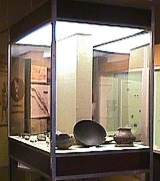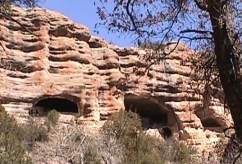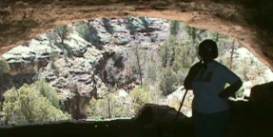Gila Cliff
Dwellings
Gila
National Forest
Silver City,
NM
March 21, 2001
While we  were staying
in New Mexico one of the names that came up constantly was a
little place called Silver City. Many people we met said that we
"just couldn't miss" Silver City. Silver City turned
out to be a wealth of history as well as many things to do in
nature. We even missed one on the way up called "the city of
rocks". In the nearby Gila (Hila) National Forest there were
a number of things to see and do. One of the things we chose was
the trail of the mountain spirits. This scenic byway follows the
footsteps of those who preceded: Mimbreno, Apache, Spaniard,
Mexican, miner, rancher, and many outdoorsman. As we approached
the Gila Cliff Dwelling National Monument I wondered to myself
how close we could get and if we could get some good pictures.
Imagine my surprise when I found out that you were allowed to
actually climb up into the Cliff Dwellings and walk around in
them. We first went to the Visitors Center and found out that the
Gila Cliff Dwellings National Monument lies at the edge of the
Gila Wilderness, the nation's first designated wilderness area.
Wilderness means that the character of the area will not be
altered by the intrusion of roads or other evidence
were staying
in New Mexico one of the names that came up constantly was a
little place called Silver City. Many people we met said that we
"just couldn't miss" Silver City. Silver City turned
out to be a wealth of history as well as many things to do in
nature. We even missed one on the way up called "the city of
rocks". In the nearby Gila (Hila) National Forest there were
a number of things to see and do. One of the things we chose was
the trail of the mountain spirits. This scenic byway follows the
footsteps of those who preceded: Mimbreno, Apache, Spaniard,
Mexican, miner, rancher, and many outdoorsman. As we approached
the Gila Cliff Dwelling National Monument I wondered to myself
how close we could get and if we could get some good pictures.
Imagine my surprise when I found out that you were allowed to
actually climb up into the Cliff Dwellings and walk around in
them. We first went to the Visitors Center and found out that the
Gila Cliff Dwellings National Monument lies at the edge of the
Gila Wilderness, the nation's first designated wilderness area.
Wilderness means that the character of the area will not be
altered by the intrusion of roads or other evidence of human presence. We would be able to glimpse
homes of prehistoric Indians which offer a glimpse of the lives
of Indians here from the 100's to 1300 A.D.
of human presence. We would be able to glimpse
homes of prehistoric Indians which offer a glimpse of the lives
of Indians here from the 100's to 1300 A.D.
Settlers in the early 1870's penetrated the mountain wilderness,
to the headwaters of the three forks of the Gila River. They were
surprised to find traces of an earlier race of men. Fallen walls
of stone, strewn with pottery fragments, clearly indicated a
people of high culture who made their homes there. It was
determined that the cliff dwellings were built in the 1280's.
These Pueblo people inhabited their homes in caves and in the
open., and examples of both are here. Probably not more than 8-10
families lived in the caves at any one time. The estimation is
that the rooms were only used for a generation.
These small, diligent, artistic people lived in cliff houses and
riverside village, tilling mesa in top and riverside fields with
digging sticks, grinding cornmeal with metate and mano,
fashioning pottery and cloth, carrying on trade with
Indians of other communities, hunting, and gathering wild plants
and fruits to supplement their squash, corn, and beans. They were
skilled potters, producing handsome brown bowls with black
interiors and black-on-white vessels. The women averaged
5'1" and the men about 5'5". They were slight of build,
yet muscular. Seven natural caves occur high in the
southeast-facing cliff, and five of the caves contain the ruins
of cliff dwellings, about 42 rooms. All the timbers seen in the
dwellings are the originals; their tree-ring dates range through
the 1280's. The cliff dwellers had abandoned their homes and
fields by 1300. Some speculate that they may have joined other
Pueblo Indians to the north or south.
pottery and cloth, carrying on trade with
Indians of other communities, hunting, and gathering wild plants
and fruits to supplement their squash, corn, and beans. They were
skilled potters, producing handsome brown bowls with black
interiors and black-on-white vessels. The women averaged
5'1" and the men about 5'5". They were slight of build,
yet muscular. Seven natural caves occur high in the
southeast-facing cliff, and five of the caves contain the ruins
of cliff dwellings, about 42 rooms. All the timbers seen in the
dwellings are the originals; their tree-ring dates range through
the 1280's. The cliff dwellers had abandoned their homes and
fields by 1300. Some speculate that they may have joined other
Pueblo Indians to the north or south.
Being a dreamer and curious by nature, I couldn't help but wonder
what caused the Indians to chose this particular area and why
these cliffs? Certainly the valley with its water running
through it had to be an enticement. However, to get the water up
into the cliff dwellings had to be a hardship. If you've ever
lifted a bucket you know how heavy water is and how difficult it
is to carry with its constantly shifting weight. To carry the
water and climb up a ladder or even to pull it up from above with
a rope would be no easy  task. So why did they choose them? One can only
guess that possibly they chose them for safety from marauding
animals or human predators. Certainly if you went into the cliffs
and pulled the ladders up at night, attack would be difficult if
not impossible. I just felt really privileged to be allowed to
walk inside the cliff dwellings and see what their lives must
have been like. In one room, which they speculate might have been
a gathering room where women did work during the day while
watching the very young children, there was a stone wall which
was built across the front opening of the cave. Obviously the
Indian women of that day had the same problems corralling their
children as did the mothers of today. Due to the size of the
openings in the front the caves were fairly well lighted. Judging
from the smoke on the ceilings I am sure that they had any number
of lighting devices, whether they were lamps of a sort, or
torches, or campfires they really don't know. Since these Indians
had no written language
task. So why did they choose them? One can only
guess that possibly they chose them for safety from marauding
animals or human predators. Certainly if you went into the cliffs
and pulled the ladders up at night, attack would be difficult if
not impossible. I just felt really privileged to be allowed to
walk inside the cliff dwellings and see what their lives must
have been like. In one room, which they speculate might have been
a gathering room where women did work during the day while
watching the very young children, there was a stone wall which
was built across the front opening of the cave. Obviously the
Indian women of that day had the same problems corralling their
children as did the mothers of today. Due to the size of the
openings in the front the caves were fairly well lighted. Judging
from the smoke on the ceilings I am sure that they had any number
of lighting devices, whether they were lamps of a sort, or
torches, or campfires they really don't know. Since these Indians
had no written language there is nothing left behind to indicate why
they chose the area or why at last they decided to move on. One
can only speculate that possibly the area had been depleted of
wildlife and they were forced to move on. The walk into the caves
was a lot easier than the way out. The walk in was precipitated
by the ledge going up to the top of the first cave. However, in
order to get down you had to climb down a ladder, much as the
Indians might have in their day. (Note: for anyone considering
this trip you can go back out the way you came without going down
the ladder.) Although I knew I could go back to the entrance, I
always feel like I have to get the whole experience, so there I
went backing down this rickety ladder. The thoughts utmost in my
mind was; I sure hope this wasn't an "original" ladder.
Whew! back on terra firma. I always like to do the adventures but
it's nice to arrive on the ground unscathed. This really was a
great experience and one that I wouldn't have missed. The walk
into and out of the caves I believe they said was around a mile.
Most of the walking was very easy and the scenery was beautiful.
there is nothing left behind to indicate why
they chose the area or why at last they decided to move on. One
can only speculate that possibly the area had been depleted of
wildlife and they were forced to move on. The walk into the caves
was a lot easier than the way out. The walk in was precipitated
by the ledge going up to the top of the first cave. However, in
order to get down you had to climb down a ladder, much as the
Indians might have in their day. (Note: for anyone considering
this trip you can go back out the way you came without going down
the ladder.) Although I knew I could go back to the entrance, I
always feel like I have to get the whole experience, so there I
went backing down this rickety ladder. The thoughts utmost in my
mind was; I sure hope this wasn't an "original" ladder.
Whew! back on terra firma. I always like to do the adventures but
it's nice to arrive on the ground unscathed. This really was a
great experience and one that I wouldn't have missed. The walk
into and out of the caves I believe they said was around a mile.
Most of the walking was very easy and the scenery was beautiful.
Good Luck! Have Fun! and Stay Safe!
Laura